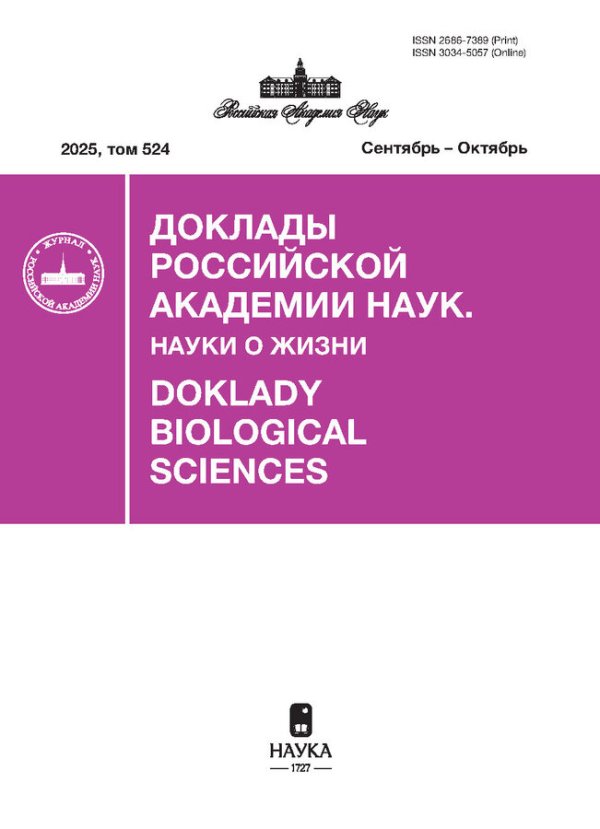НОКАУТ ПО ГЕНУ PARP1 ПОДАВЛЯЕТ ЭКСПРЕССИЮ ГЕНОВ ЭКСЦИЗИОННОЙ РЕПАРАЦИИ ОСНОВАНИЙ ДНК
- Авторы: Захаренко А.Л.1, Малахова А.А.1,2,3, Дырхеева Н.С.1, Окорокова Л.С.4, Медведев С.П.1,2,3, Закиян С.М.1,2,3, Кабилов М.Р.1, Тупикин А.А.1, Лаврик О.И.1
-
Учреждения:
- Институт химической биологии и фундаментальной медицины Сибирского отделения Российской академии наук
- Федеральный исследовательский центр Институт цитологии и генетики Сибирского отделения Российской академии наук
- Федеральное государственное бюджетное учреждение “НМИЦ им. ак. Е.Н. Мешалкина” Минздрава России
- ООО “АкадемДжин”
- Выпуск: Том 510, № 1 (2023)
- Страницы: 219-224
- Раздел: Статьи
- URL: https://journals.rcsi.science/2686-7389/article/view/135686
- DOI: https://doi.org/10.31857/S2686738922600959
- EDN: https://elibrary.ru/UNDXZB
- ID: 135686
Цитировать
Полный текст
Аннотация
Изучено влияние нокаута по гену PARP1 в клетках НЕК293 на экспрессию генов белков эксцизионной репарации оснований ДНК (base excision repair, BER). Показано, что экспрессия всех дифференциально экспрессируемых генов (ДЭГ) BER снижена под действием нокаута. Наиболее сильно изменилась экспрессия гена ДНК-гликозилазы NEIL1, которая считается одним из общих “узлов” для связывания белков BER. Также значительно снижена экспрессия генов вспомогательных субъединиц ДНК-полимераз δ и ε. Полученная нами линия клеток с нокаутом по гену PARP1 представляет собой адекватную клеточную модель для изучения активности процесса BER в отсутствие PARP1 и тестирования препаратов, направленных на ингибирование процессов репарации. Впервые обнаружено, что при нокауте гена PARP1 происходит значительное изменение уровня экспрессии белков, ответственных за биогенез рибосом и функционирование протеасомы.
Ключевые слова
Об авторах
А. Л. Захаренко
Институт химической биологии и фундаментальной медицины Сибирского отделения Российской академии наук
Email: dyrkheeva.n.s@gmail.com
Россия, Новосибирск
А. А. Малахова
Институт химической биологии и фундаментальной медицины Сибирского отделения Российской академии наук; Федеральный исследовательский центрИнститут цитологии и генетики Сибирского отделения Российской академии наук; Федеральное государственное бюджетное учреждение “НМИЦ им. ак. Е.Н. Мешалкина” Минздрава России
Email: dyrkheeva.n.s@gmail.com
Россия, Новосибирск; Россия, Новосибирск; Россия, Новосибирск
Н. С. Дырхеева
Институт химической биологии и фундаментальной медицины Сибирского отделения Российской академии наук
Автор, ответственный за переписку.
Email: dyrkheeva.n.s@gmail.com
Россия, Новосибирск
Л. С. Окорокова
ООО “АкадемДжин”
Email: dyrkheeva.n.s@gmail.com
Россия, Новосибирск
С. П. Медведев
Институт химической биологии и фундаментальной медицины Сибирского отделения Российской академии наук; Федеральный исследовательский центрИнститут цитологии и генетики Сибирского отделения Российской академии наук; Федеральное государственное бюджетное учреждение “НМИЦ им. ак. Е.Н. Мешалкина” Минздрава России
Email: dyrkheeva.n.s@gmail.com
Россия, Новосибирск; Россия, Новосибирск; Россия, Новосибирск
С. М. Закиян
Институт химической биологии и фундаментальной медицины Сибирского отделения Российской академии наук; Федеральный исследовательский центрИнститут цитологии и генетики Сибирского отделения Российской академии наук; Федеральное государственное бюджетное учреждение “НМИЦ им. ак. Е.Н. Мешалкина” Минздрава России
Email: dyrkheeva.n.s@gmail.com
Россия, Новосибирск; Россия, Новосибирск; Россия, Новосибирск
М. Р. Кабилов
Институт химической биологии и фундаментальной медицины Сибирского отделения Российской академии наук
Email: dyrkheeva.n.s@gmail.com
Россия, Новосибирск
А. А. Тупикин
Институт химической биологии и фундаментальной медицины Сибирского отделения Российской академии наук
Email: dyrkheeva.n.s@gmail.com
Россия, Новосибирск
О. И. Лаврик
Институт химической биологии и фундаментальной медицины Сибирского отделения Российской академии наук
Автор, ответственный за переписку.
Email: lavrik@niboch.nsc.ru
Россия, Новосибирск
Список литературы
- Karpinska A. Quantitative analysis of biochemical processes in living cells at a single-molecule level: a case of olaparib–PARP1 (DNA repair protein) interactions. // 2021. Analyst. V. 146. № 23. P. 7131–7143.
- Ходырева С.Н., Лаврик О.И. Поли(ADP-рибоза)полимераза 1 – ключевой регулятор репарации ДНК // Молекуляр. биология. 2016. Т. 50. С. 655–673.
- Xie N., Zhang L., Gao W., et al. NAD + metabolism: pathophysiologic mechanisms and therapeutic potential. // Signal Transduction and Targeted Therapy. 2020. V. 5. № 1. P. 227.
- Suskiewicz M.J., Palazzo L., Hughes R., Ahel I. Progress and outlook in studying the substrate specificities of PARPs and related enzymes // FEBS J. 2021. V. 288. № 7. P. 2131–2142.
- Martin-Hernandez K., Rodriguez-Vargas J.M., Schreiber V., et al. Expanding functions of ADP-ribosylation in the maintenance of genome integrity // Cell Dev. Biol. 2017. V. 63 P. 92–101.
- Lüscher B., Ahel I., Altmeyer M., et al. ADP-ribosyltransferases, an update on function and nomenclature // FEBS J. 2021. V. 29. https://doi.org/10.1111/febs.16142
- Luger K., Dechassa M.L., Tremethick D.J. New insights into nucleosome and chromatin structure: an ordered state or a disordered affair? // Nat. Rev. Mol. Cell Biol. 2012. V. 13. № 7. P. 436–447.
- Saville K.M., Clark J., Wilk A., Rogers G.D., et al. NAD+-mediated regulation of mammalian base excision repair // DNA Repair (Amst). 2020. V. 93. P. 102930.
- Lavrik O.I. PARPs’ impact on base excision DNA repair // DNA Repair (Amst). 2020. V. 93. P. 102911.
- Almeida K.H., Sobol R.W. A unified view of base excision repair: lesion-dependent protein complexes regulated by post-translational modification // DNA Repair (Amst). 2007. V. 6. № 6. P. 695–711.
- Svilar D., Goellner E.M., Almeida K.H., Sobol R.W. Base excision repair and lesion-dependent subpathways for repair of oxidative DNA damage // Antioxid. Redox Signal. 2011. V. 14. P. 2491–2507.
- Caldecott K.W. Mammalian DNA base excision repair: Dancing in the moonlight // DNA Repair (Amst). 2020. V. 93. P. 102921.
- Baiken Y., Kanayeva D., Taipakova S., et al. Role of Base Excision Repair Pathway in the Processing of Complex DNA Damage Generated by Oxidative Stress and Anticancer Drugs // Front. Cell Dev. Biol. 2021. V. 22. № 8. P. 617884.
- Vodenicharov M.D., Sallmann F.R., Satoh M.S., Poirier G.G. Base excision repair is efficient in cells lacking poly(ADP-ribose) polymerase 1 // Nucleic Acids Res. 2000. V. 28. № 20. P. 3887–3896.
- Ménissier de Murcia J., Ricoul M., Tartier L., et al. Functional interaction between PARP-1 and PARP-2 in chromosome stability and embryonic development in mouse // EMBO J. 2003. V. 22. № 9. P. 2255–2563.
- Larmonier C.B., Shehab K.W., Laubitz D., et al. Transcriptional Reprogramming and Resistance to Colonic Mucosal Injury in Poly(ADP-ribose) Polymerase 1 (PARP1)-deficient Mice // J. Biol. Chem. 2016. V. 291. № 17. P. 8918–8930.
- Tong W.M., Cortes U., Wang Z.Q. Poly(ADP-ribose) polymerase: a guardian angel protecting the genome and suppressing tumorigenesis // Biochim. Biophys. Acta. 2001. V. 1552. № 1. P. 27–37.
- Murai J., Huang S.N., Das B.B., et al. Trapping of PARP1 and PARP2 by Clinical PARP Inhibitors // Cancer Res. 2012. V. 72. № 21. P. 5588–5599.
- Dyrkheeva N.S., Filimonov A.S., Luzina O.A., et al. New Hybrid Compounds Combining Fragments of Usnic Acid and Thioether Are Inhibitors of Human Enzymes TDP1, TDP2 and PARP1 // Int. J. Mol. Sci. 2021. V. 22. № 21. P. 11336.
- Noren Hooten N., Fitzpatrick M., Kompaniez K., et al. Coordination of DNA repair by NEIL1 and PARP-1: a possible link to aging // Aging (Albany NY). 2012. V. 4. № 10. P. 674–685.
- Hazra T.K., Izumi T., Boldogh I., et al. Identification and characterization of a human DNA glycosylase for repair of modified bases in oxidatively damaged DNA // Proc. Natl. Acad. Sci. USA. 2002. V. 99. № 6. P. 3523–3528.
- Dou H., Theriot C.A., Das A., et al. Interaction of the human DNA glycosylase NEIL1 with proliferating cell nuclear antigen. The potential for replication-associated repair of oxidized bases in mammalian genomes // J. Biol. Chem. 2008. V. 283. P. 3130–3140.
- Hegde M.L., Theriot C.A., Das A., et al. Physical and functional interaction between human oxidized base-specific DNA glycosylase NEIL1 and flap endonuclease 1 // J. Biol. Chem. 2008. V. 283. P. 27028–27037.
- Wiederhold L., Leppard J.B., Kedar P., et al. AP endonuclease-independent DNA base excision repair in human cells // Molecular cell. 2004. V. 15. P. 209–220.
- Boorstein R.J., Cummings Jr.A., Marenstein D.R., et al. Definitive identification of mammalian 5-hydroxymethyluracil DNA N-glycosylase activity as SMUG1 // J. Biol. Chem. 2001. V. 276. № 45. P. 41991–41997.
- Haushalter K.A., Todd Stukenberg M.W., Kirschner M.W., Verdine G.L. Identification of a new uracil-DNA glycosylase family by expression cloning using synthetic inhibitors // Curr. Biol. 1999. V. 9. № 4. P. 174–185.
- Chakravarti D., Ibeanu G.C., Tano K., Mitra S. Cloning and expression in Escherichia coli of a human cDNA encoding the DNA repair protein N-methylpurine-DNA glycosylase // J. Biol. Chem. 1991. V. 266. № 24. P. 15710–15715. J. Biol. Chem. 1991 Aug 25;266(24):15710-5.
- Kunkel T.A., Burgers P.M. Dividing the workload at a eukaryotic replication fork // Trends Cell Biol. 2008. V. 18. № 11. P. 521–527.
- Hubscher U., Spadari S., Villani G., Maga G. DNA Polymerases: Discovery, Characterization, and Functions in Cellular DNA Transactions // 1st Ed. World Scientific Publishing Co. Singapore. 2010.
- Dianov G.L., Sleeth K.M., Dianova I.I., Allinson S.L. Repair of abasic sites in DNA // Mutat. Res. 2003. V. 531. № 1–2. P. 157–163.
- Waters L.S., Minesinger B.K., Wiltrout M.E., et al. Eukaryotic translesion polymerases and their roles and regulation in DNA damage tolerance // Microbiol. Mol. Biol. Rev. 2009. V. 73. P. 134–154.
- Li Y., Pursell Z.F., Linn S. Identification and cloning of two histone fold motif-containing subunits of HeLa DNA polymerase epsilon // J. Biol. Chem. 2000. V. 275. № 30. P. 23247–23252.
- Bellelli R., Belan O., Pye V.E., et al. POLE3-POLE4 Is a Histone H3-H4 Chaperone that Maintains Chromatin Integrity during DNA Replication. Mol. Cell. 2018. V. 72. № 1. P. 112–126.e5.
- Liu L., Mo J., Rodriguez-Belmonte E.M., Lee M.Y. Identification of a fourth subunit of mammalian DNA polymerase delta // J. Biol. Chem. 2000. V. 275. № 25. P. 18739–18744.
- Hanzlikova H., Kalasova I., Demin A.A., et al. The Importance of Poly(ADP-Ribose) Polymerase as a Sensor of Unligated Okazaki Fragments during DNA Replication // Mol. Cell. 2018. V. 71. № 2. P. 319–331.e3.
- Maga G., van Loon B., Crespan E., et al. The block of DNA polymerase delta strand displacement activity by an abasic site can be rescued by the concerted action of DNA polymerase beta and Flap endonuclease 1 // J. Biol. Chem. 2009. V. 284. № 21. P. 14267–14275.
- Sanderson R.J., Lindahl T. Down-regulation of DNA repair synthesis at DNA single-strand interruptions in poly(ADP-ribose) polymerase-1 deficient murine cell extracts // DNA Repair (Amst). 2002. V. 1. № 7. P. 547–58.
- Villani G., Hubscher U., Gironis N., et al. In vitro gap-directed translesion DNA synthesis of an abasic site involving human DNA polymerases epsilon, lambda, and beta // J. Biol. Chem. 2011. V. 286. № 37. P. 32094–32104.
- Моор Н.А., Лаврик О.И. Белок-белковые взаимодействия системы эксцизионной репарации оснований ДНК // Биохимия. 2018. Т. 83. В. 4. С. 564–576.
Дополнительные файлы












